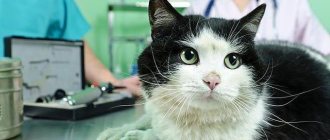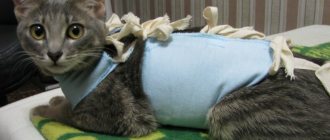What is sterilization and when is it performed?
There are two types of surgical intervention in the reproductive system of an animal - sterilization and castration. The most commonly heard are castration of a cat and sterilization of a cat, although this is incorrect from the point of view of terminology. These types of operations apply to animals of both sexes and differ in purpose:
- Castration is the complete removal of the gonads (testes in cats and ovaries in cats). The operation stops the animal's production of sex hormones, making it uninterested in mating and reproduction.
- Sterilization is a more gentle procedure. Its essence is the ligation of the vas deferens in cats and the fallopian tubes in cats. The synthesis of sex hormones does not stop, but the animal cannot have offspring. Sterilization does not solve the problem of sexual hunting and does not affect the behavior of the pet.
When deciding to undergo surgery on your pet, evaluate the positive and negative aspects of this action.
Table: advantages and disadvantages of sterilization
| pros | Minuses |
| Lack of unwanted offspring. | The likelihood of complications is the same as after any surgical intervention. |
| Protecting the animal from problems associated with pregnancy and childbirth. | Risk with anesthesia. |
| Significant reduction in the risk of breast tumors. | The need for special care in the period after surgery. |
| Reducing the likelihood of infection during uncontrolled matings or fights during the heat period. | Following a special diet to avoid obesity. |
| Increasing the pet's lifespan. | Change in animal behavior: the cat will become less energetic. |
Video: the pros and cons of sterilizing cats
When is the best time to have surgery?
If you decide to sterilize your furry pet, do it at an age when the body is almost fully formed, but the first heat has not yet occurred - at 7-10 months. It is at this age that the cat tolerates surgery more easily and recovers faster. Sterilization during this period of life will reduce the risk of breast tumors to almost zero. If for some reason it was not possible to have the operation before the onset of the first heat, do not be discouraged: sterilization can be performed at any age from 7 months to 10 years. It is only important to know about some nuances:
- if the cat has already been in heat, perform the operation no earlier than 2 weeks after its end, making sure that your pet is not in an “interesting position”;
- if a cat has recently given birth to kittens, do not rush to sterilize the furry lady: she needs at least 1.5–2 months to recover after giving birth and feed the babies, and an operation performed earlier than a month after giving birth will have a negative impact on her health;
It is recommended to sterilize a cat who has recently given birth to kittens after she has nursed her babies.
- if the cat has entered the period of heat, and it is not possible to wait until the end of estrus, surgery is possible, although this will lead to some complications: the main risk of surgery during estrus is the likelihood of severe bleeding, but the cat will also take longer to recover, and the need to lick itself frequently, caused by estrus, can lead to injury to postoperative sutures.
Reasons for sterilizing adult cats
Veterinary experts recommend sterilizing a middle-aged cat as soon as possible. Firstly, you should not postpone surgery until you are very old. Secondly, the older the cat, the higher the likelihood that she will develop diseases related to the genital organs. So, the main reasons to sterilize an adult cat:
- preventing pregnancy. The older the cat, the more difficult her pregnancy may be, the greater the risks of childbirth; Sterilization is an easy way to avoid this.
- With age, the likelihood of developing inflammatory diseases, cancer of the ovaries and uterus, and hormonal imbalances increases - sterilization obviously helps prevent this.
- stopping unwanted behavior: the cat will no longer ask the cat.
Contraindications
There are a number of cases when a cat cannot be sterilized:
- young age - surgery before the age of 6 months can lead to abnormalities of physiological development and multiple complications;
- intolerance to anesthetic drugs, allergic reactions;
- the age of the animal is more than 10 years - at an advanced age it is more difficult to undergo surgery and recover from it, anesthesia can undermine the health of your pet;
- exhausted, weakened state after illness;
- if the animal was vaccinated less than a month ago.
In such cases, drugs are used to suppress estrus or regulate the sexual behavior of the furry lady. But only a veterinarian should prescribe them.
Before surgery
Surgical intervention is an important and responsible event in the life of your pet, so you should prepare for it in advance:
- Get your cat vaccinated at least a month before the scheduled surgery. Their absence increases the risk of contracting various infections. Even a cat that does not leave the apartment runs the risk of getting sick, especially during the period when its immune system is already working at its maximum.
- Treat the animal for parasites. If more than a month has passed since the last time you took anti-worm medications, then repeat the procedure approximately 10 days before surgery.
- Do not feed your cat 10–12 hours before surgery. Anesthesia can cause vomiting, which will cause discomfort for both the cat and its owner. However, your pet is not prohibited from drinking water during this period. Don't worry about the hungry looks your cat will give you during this time. Remember that she is a predator; her body can tolerate the absence of food for two days without harm to itself.
- On the way to the veterinary clinic, be gentle with your pet, talk to it, pet it. If possible, walk the distance to the clinic. This will reduce the level of stress that the four-legged patient will experience.
Pet your cat to calm her down before surgery
Types and methods of surgical intervention
There are several types of surgical intervention in the reproductive system of cats. They differ in the method of implementation and purpose:
- Ovariohysterectomy. The essence of the operation is that both the uterus and ovaries of the cat are removed through an incision in the abdomen. The result is the complete elimination of sexual desire and the ability to reproduce. This is the optimal way to castrate cats and older animals that have already given birth.
- Ovariectomy. The operation involves removing the ovaries while preserving the uterus. During surgery, two small incisions are made through which the ovaries are removed with a special instrument and then amputated. Like an ovariohysterectomy, the procedure stops sexual activity and the ability to reproduce. It is applied to cats that have not yet gone into heat.
- Chemical sterilization. It involves introducing drugs into the cat’s body that reduce the production of sex hormones. It gives a temporary effect and is prescribed only in cases where surgical intervention is impossible (for example, if the cat is sick). Long-term use of such drugs leads to a number of serious diseases, including oncology.
- Tubal occlusion. The essence of the operation is that the fallopian tubes are ligated, but other organs of the reproductive system remain intact. Its result is the preservation of the cat’s sexual behavior, but the inability to have offspring. This is classic sterilization.
Access to the reproductive organs of an animal for the purpose of sterilization is carried out in three ways:
- An incision is made along the linea alba. The most common method. Suitable for ovariohysterectomy. The cat's fur is shaved from the navel to the last pair of nipples, and an incision is made through which the uterus and ovaries are removed. The incision is relatively large, but passes through the connective tissue without injuring the muscles.
- Side cut. Used in oophorectomy. It is small in size, so it is used in the sterilization program for homeless animals. Veterinarians do not like this method due to the inability to visually assess the condition of internal organs. With small incisions, it is quite traumatic, since it is performed directly through muscle tissue.
- Laparoscopy. It is performed by introducing a laparoscope and a special manipulator into the abdominal cavity through small punctures (less than 1 cm in length). Does not require sutures, combines the possibility of full visual control and ultra-low tissue trauma. It is the most expensive, as it requires special equipment and a doctor with appropriate qualifications.
Surgical intervention for sterilizing a cat is performed along the linea alba (1), lateral incision (2) or by laparoscopy (3)
Pros and cons of the operation, which type is most optimal
Only the owner and the veterinarian decide whether to sterilize or not. This procedure has both positive and negative consequences, which should be discussed in more detail.
Pros of sterilization:
- the possibility of the cat having unwanted offspring is excluded;
- behavior correction;
- the development of certain diseases of the reproductive system is excluded - for example, tumors and neoplasms in the uterus, mammary glands and ovaries;
- increasing the life expectancy of the animal - a sterilized cat lives on average 3-4 years longer than a non-sterilized one;
- regulation of the number of homeless and stray animals.
Video: the pros and cons of sterilizing a cat
Minuses:
- severe animal stress - surgery and the recovery period can have a very negative impact on the cat’s health;
- decreased physical activity, which, if consumed in moderation, threatens obesity and the development of serious diseases - diabetes, urolithiasis, allergies, heart disease;
- postoperative consequences in the form of urinary incontinence;
- the occurrence of cysts and tumors in the uterus or ovaries - during tubal occlusion and hysterectomy;
- symmetrical baldness in long-haired cats.
The most optimal method of sterilization today is removal of the ovaries (oophorectomy) - it completely eliminates the possibility of a cat becoming pregnant, corrects its hormonal levels and behavior, and eliminates the occurrence of most diseases of the reproductive system.
Important! Most of the negative consequences of sterilization occur due to improper care in the postoperative period. Therefore, wearing a special bandage, optimal diet, rest and proper care of the animal during the recovery period are the key to a speedy recovery and return to a full life.
After operation
When the doctor brings your pet out of the operating room, most likely at that moment she will still be under anesthesia or just beginning to come to her senses. At this time, she needs your help.
To transport home, wrap your furry lady in something warm, such as a blanket or towel. In the cold season, a heating pad or at least a bottle of warm water will be useful. After anesthesia, a cat's heartbeat slows down significantly and her body temperature drops, so she gets cold and needs warmth. When you arrive home, place the animal on the floor covered with oilcloth and a soft, lint-free cloth. In the room where the furry lady will come to her senses, there should be no sources of loud noise or bright light. When your cat wakes up, keep a close eye on her. Being in a state of residual anesthesia, staggering, falling and crashing into furniture, she can injure herself. If your pet wants to move from the floor to her favorite hiding place, help her, but continue to watch closely, especially if the hiding place is located high off the floor.
Do not let your cat drink water until she has fully recovered from the anesthesia. This usually takes several hours. And feed after surgery only when her appetite returns - usually after 1 day.
In the first 2-3 days after surgery, put a special blanket on your cat. Such fabric clothing with ties will protect the wound from contamination and will prevent the cat from disturbing the stitches while licking. Animals are usually indifferent to healing wounds, but there are exceptions to any rule. If the cat shows excessive interest in the stitches, leave it in a blanket until the wounds are completely healed.
A cat blanket will help prevent injury to postoperative sutures
Pay special attention to caring for seams. Your veterinarian will provide instructions and advice after surgery. On the second or third day after surgery, the sutures are treated with brilliant green, hydrogen peroxide, chlorhexidine or Levomekol ointment. In the first time after surgery, swelling of the suture, its redness and discharge of ichor are acceptable. This is the body's natural reaction to surgical trauma.
In the absence of complications, the postoperative suture does not bleed
Possible complications
There are a number of signs that, if you notice them, it is important to immediately consult a veterinarian:
- the appearance of a rash and swelling of the cat’s eyelids, lips and tongue;
- suture bleeding;
- redness or pallor of the mucous membranes;
- arrhythmia and bradycardia;
- decrease or increase in body temperature;
- heavy breathing with wheezing.
After the operation, complications are likely that the cat owner needs to be aware of:
- Hernia. It occurs when the integrity of the internal suture is violated and represents a prolapse of internal organs into the subcutaneous sac. Looks like a bump around the outer seam. In this case, the cat requires repeated surgery.
- Lethargy and drowsiness. Usually a healthy cat recovers from anesthesia in less than 24 hours. You should immediately contact a veterinarian if lethargy and drowsiness have not gone away within 24 hours, the cat has lost its appetite and does not drink water, there is tremors and vomiting, and the swelling of the suture has not subsided after two weeks. This condition of the cat requires special therapy.
- Enlargement of the mammary glands. If the mammary glands become swollen after sterilization, a false pregnancy is diagnosed. To avoid this complication, protect your cat after surgery from hypothermia and stress.
Changes in character
After sterilization, the cat’s body stops producing sex hormones, which inevitably leads to a change in the furry lady’s behavior. The main one is stopping estrus. The cat will stop having hysterics due to amorous suffering and nightly “concerts”, she will become calmer and more balanced, friendly towards other animals. She will no longer have mood swings from apathy to bursts of excessive energy and back.
If before the operation your pet had a quarrelsome character, then after sterilization he will soften and aggression will decrease. Sterile cats become more affectionate. They lose their maternal instinct and interest in other people's cubs, but they can lick their coat for hours, bringing it into immaculate condition.
Neutered cats have an increased desire to be clean and beautiful, so they can groom themselves for hours
Caring for a sterilized cat
Keeping a sterilized cat is not much different from caring for an unsterilized pet. You won’t have to worry about an unwanted pregnancy, endure her antics during estrus, or worry about taking sedatives and anti-estrus medications in a timely manner.
Proper nutrition is very important for the animal. Changes in hormonal levels and a less active lifestyle than before can lead to a cat becoming overweight. To avoid this, switch your furry friend to specialized food for sterilized cats. It has a minimal content of phosphorus, magnesium and calcium, which prevents the development of urolithiasis.
A reduced amount of fat in the diet will help your pet stay in shape.
If before the operation the diet consisted of natural products, then after it more often give the cat boiled vegetables and low-fat dairy products. Various delicacies from the master's table are harmful to animals both before and after sterilization. Do not feed your pet various sausages, chips and other harmful “goodies”.
A neutered cat should have a diet low in fat, calcium and magnesium.
General behavior change
Don't worry if your cat becomes lazy, fat or bored after spaying. This procedure itself does not cause these side effects, although it does reduce your pet's motivation to move around somewhat. About one in four cat owners believe that neutering has made their pet calmer, but most cats show no noticeable changes in behavior.
Young cats return to their normal routine within a few days after surgery, but older cats may take just a little longer. If your cat has been healthy for more than 8-10 years, recovery may take up to several weeks to get used to life with fewer hormones.











